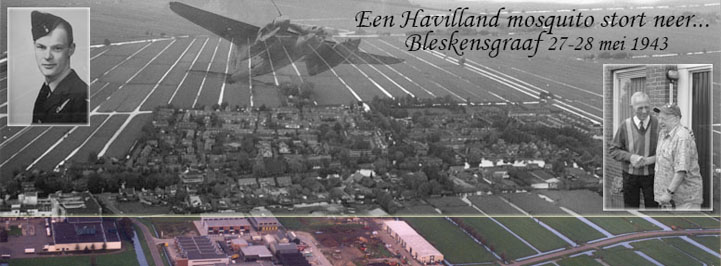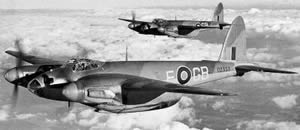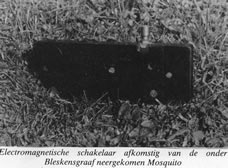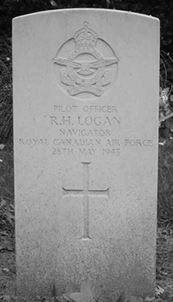


A story from the book "The Waard in time of war" Part 1 about what is happend that night at Bleskensgraaf written by A. Korpel. 1983
 It's night in the Alblasserwaard. The most calenders are still on May 27, 1943 a few already on May 28. The town lays in deep rest. Then suddenly, it's about two o' clock. The people of Bleskensgraaf get awake trough a loud noise. Above the village they hear the sound of aircraftengines, mixed with the sound of gunfire. An English nightfighter is chased by a German aircraft. The English airplane an mosquito of the109th RAF squadron did't know to get away of his challenger. The burning plane comes down northeast of Bleskensgraaf. In the polder Zevenhoven, on the fields border of the farmers van den Berg and de Groot.
It's night in the Alblasserwaard. The most calenders are still on May 27, 1943 a few already on May 28. The town lays in deep rest. Then suddenly, it's about two o' clock. The people of Bleskensgraaf get awake trough a loud noise. Above the village they hear the sound of aircraftengines, mixed with the sound of gunfire. An English nightfighter is chased by a German aircraft. The English airplane an mosquito of the109th RAF squadron did't know to get away of his challenger. The burning plane comes down northeast of Bleskensgraaf. In the polder Zevenhoven, on the fields border of the farmers van den Berg and de Groot.
The Mosquito was originally a fighterplane. Before the war the tasks of different types of aircraft where clearly defined. Fighters were only equipped to fight and bombers only for the dropping of the bombs. As the war advanced the dividing line between these tasks became less clear. It happens now that fighter planes dropping bombs and bombers where armed to fight. Around 1943 the mainforces using aircraft that combines the duties of the former fighters as well as the bombers can do other tasks. A Mosquito fighter-bomber can carry a bombload of two x 900 kg of bombs, it has availible four 7.7 mm machine-guns in the nose and four Hispano 20 mm cannons in the cockpit floor.The wingspan of the aircraft is 16.51 meters, it is 12.55 meters in length and has a height 4.65 meters.The weight is 9500 kg. The propellers are powered by 2 Rolls Royce merlin engines , who gave the airplane a cruising speed of almost 400 km per hour. The Mosquito is at that time the fastest warplane of the world. The range is 2400 km (This could be enlarged with additional tanks under the wings.) The airplane can also serve as photo reconnaissance aircraft and has a camera available for that task in the bottom of the bombbay. Furthermore, the aircrraft was frequently used as a "pathfinder" for the marking of the bombing targets.
 De Havilland Mosquito is a very special plane, it is almost a complete wooden constuction, and so fast that it because it's speed it can avoid attacks of the German fighters and so it would be not necessary to carry the weight of defensive armament. The airplane especially become famous because it's attacks that are carried out on Berlin. Once Mosquito's bombed 63 nights consecutively Berlin. Mosquito means as much as stable-fly or mosquito and is true to its name, because it's able to place sensitive stabbing to the German "body" a lot.
De Havilland Mosquito is a very special plane, it is almost a complete wooden constuction, and so fast that it because it's speed it can avoid attacks of the German fighters and so it would be not necessary to carry the weight of defensive armament. The airplane especially become famous because it's attacks that are carried out on Berlin. Once Mosquito's bombed 63 nights consecutively Berlin. Mosquito means as much as stable-fly or mosquito and is true to its name, because it's able to place sensitive stabbing to the German "body" a lot.
Although the Mosquito's speed is his best defence, it happens sometimes that a airplane is shot down by German hunters.  There's sometimes a Mozzie lost as in this night above Bleskensgraaf. The two crew does everything its utmost to escape his challenger but it's no use. The pilot C.K. Chrysler of the Royal Canadian Air Force has saved his life with his parachute. He is landed somewhere behind Braank (Brandwijk). Total battered and injured he err to the fourth mill of Groot Ammers. There he decides to return to the burning remains of his aircraft.
There's sometimes a Mozzie lost as in this night above Bleskensgraaf. The two crew does everything its utmost to escape his challenger but it's no use. The pilot C.K. Chrysler of the Royal Canadian Air Force has saved his life with his parachute. He is landed somewhere behind Braank (Brandwijk). Total battered and injured he err to the fourth mill of Groot Ammers. There he decides to return to the burning remains of his aircraft.
His fellow-countryman the navigator R.H. Logan, landed half in a ditch. He got killed. Local people find him the next morning and his body is brought to policeman de Groot. He brings the airman Logan to the towns cemetery in Bleskensgraaf and lays his body to the bier. Later that day they are picked up by German soldiers and transported to Rotterdam.
In the polder Zevenhoven remain the debris of their aircraft stay behind. The wreckage of the "Mozzie" lies scattered on the meadows. The two engines of the plane has never been unearth. These are still burried in the soft soil.
If the Germans lifting surveillance around the aircraft, the people scrapped the remnats. Many souvenirs of this unfortunate airplane is can still be found in Bleskensgraaf and environment.